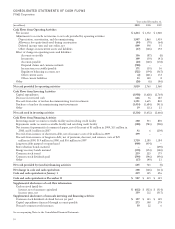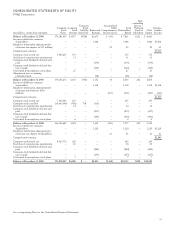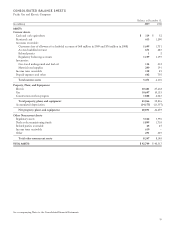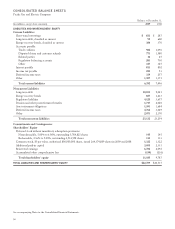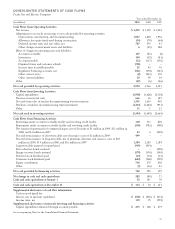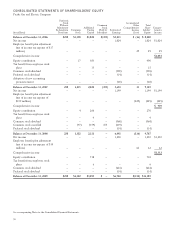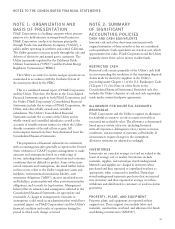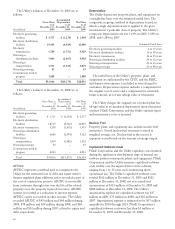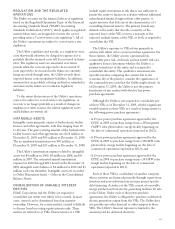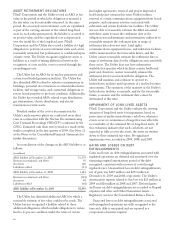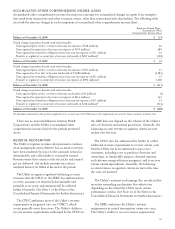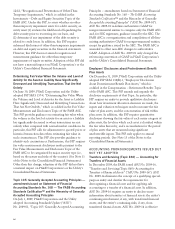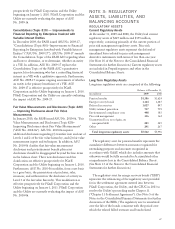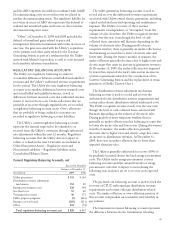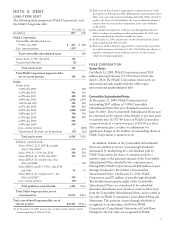PG&E 2009 Annual Report Download - page 65
Download and view the complete annual report
Please find page 65 of the 2009 PG&E annual report below. You can navigate through the pages in the report by either clicking on the pages listed below, or by using the keyword search tool below to find specific information within the annual report.REGULATION AND THE REGULATED
OPERATIONS
The Utility accounts for the financial effects of regulation
based on the Regulated Operations Topic of the Financial
Accounting Standards Board (“FASB”) Accounting
Standards Codification (“ASC”), which applies to regulated
entities whose rates are designed to recover the cost of
providing service (“cost-of-service rate regulation”). All of
the Utility’s operations are subject to cost-of-service rate
regulation.
The Utility capitalizes and records, as a regulatory asset,
costs that would otherwise be charged to expense if it is
probable that the incurred costs will be recovered in future
rates. The regulatory assets are amortized over future
periods when the costs are expected to be recovered. If
costs expected to be incurred in the future are currently
being recovered through rates, the Utility records those
expected future costs as regulatory liabilities. In addition,
amounts that are probable of being credited or refunded to
customers in the future are recorded as regulatory
liabilities.
To the extent that portions of the Utility’s operations
cease to be subject to cost-of-service rate regulation, or
recovery is no longer probable as a result of changes in
regulation or other reasons, the related regulatory assets
and liabilities are written off.
INTANGIBLE ASSETS
Intangible assets primarily consist of hydroelectric facility
licenses and other agreements, with lives ranging from 19
to 40 years. The gross carrying amount of the hydroelectric
facility licenses and other agreements was $110 million at
December 31, 2009 and $95 million at December 31, 2008.
The accumulated amortization was $40 million at
December 31, 2009 and $35 million at December 31, 2008.
The Utility’s amortization expense related to intangible
assets was $4 million in 2009, $4 million in 2008, and $3
million in 2007. The estimated annual amortization
expense for 2010 through 2013 based on the December 31,
2009 intangible assets balance is $4 million for 2010 and $3
million each year thereafter. Intangible assets are recorded
to Other Noncurrent Assets — Other in the Consolidated
Balance Sheets.
CONSOLIDATION OF VARIABLE INTEREST
ENTITIES
PG&E Corporation and the Utility are required to
consolidate any entity over which it has control. In most
cases, control can be determined based on majority
ownership. However, for certain entities, control is difficult
to discern based on voting equity interests only. These
entities are referred to as VIEs. Characteristics of a VIE
include equity investment at risk that is not sufficient to
permit the entity to finance its activities without additional
subordinated financial support from other parties, or
equity investors that lack any of the characteristics of a
controlling financial interest. The primary beneficiary,
defined as the entity that absorbs a majority of the
expected losses of the VIE, receives a majority of the
expected residual returns of the VIE, or both, is required to
consolidate the VIE.
The Utility’s exposure to VIEs relates primarily to
entities with which it has a power purchase agreement. For
those entities, the Utility assesses operational risk,
commodity price risk, credit risk, and tax benefit risk on a
qualitative basis to determine whether the Utility is a
primary beneficiary of the entity and is required to
consolidate the entity. This qualitative assessment also
typically involves comparing the contract life to the
economic life of the plant to consider the significance of
the commodity price risk that the Utility might absorb. As
of December 31, 2009, the Utility is not the primary
beneficiary of any entities with which it has power
purchase agreements.
Although the Utility is not required to consolidate any
of these VIEs as of December 31, 2009, it held a significant
variable interest in three VIEs as a result of being a party to
the following power purchase agreements:
• A 25-year power purchase agreement approved by the
CPUC in 2009 to purchase energy from a 250-megawatt
(“MW”) solar photovoltaic energy facility beginning on
the date of commercial operations (expected in 2012);
• A 20-year power purchase agreement approved by the
CPUC in 2009 to purchase energy from a 550 MW solar
photovoltaic energy facility beginning on the date of
commercial operations (expected in 2013); and
• A 25-year power purchase agreement approved by the
CPUC in 2008 to purchase energy from a 554 MW solar
trough facility beginning on the date of commercial
operations (expected in 2011).
Each of these VIEs is a subsidiary of another company
whose activities are financed primarily through equity from
investors and proceeds from non-recourse project-specific
debt financing. Activities of the VIEs consist of renewable
energy production from electric generating facilities for sale
to the Utility. Under each of the power purchase
agreements, the Utility is obligated to purchase as-delivered
electric generation output from the VIEs. The Utility does
not provide any other financial or other support to these
VIEs. The Utility’s financial exposure is limited to the
amounts paid for delivered electricity.
61



